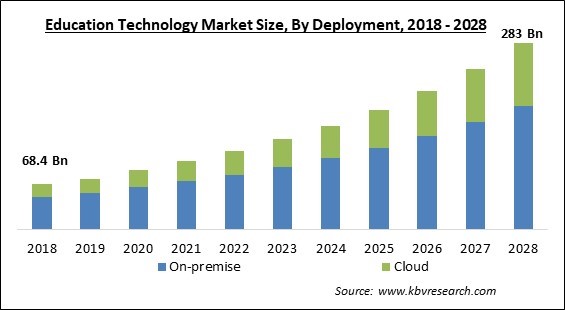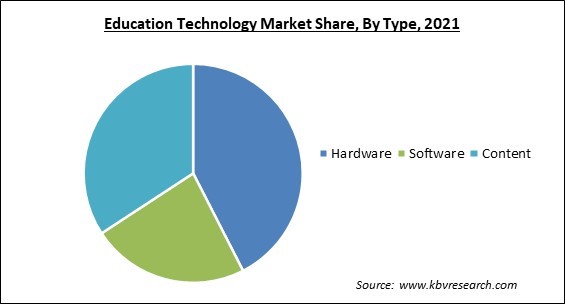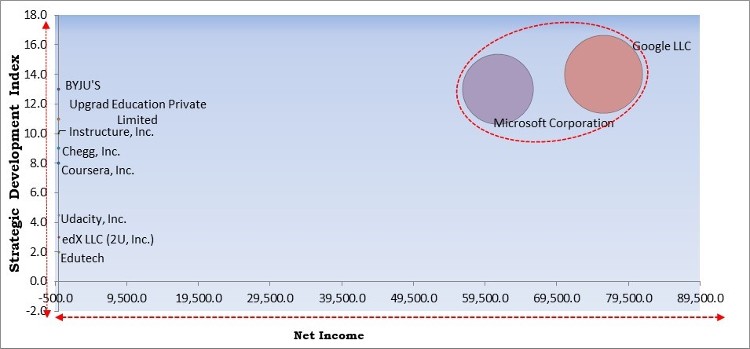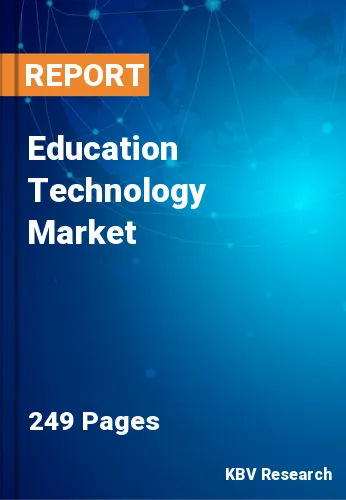The Global Education Technology Market size is expected to reach $283 billion by 2028, rising at a market growth of 15.5% CAGR during the forecast period.
Education technology (EdTech) refers to hardware and software that is used to educate children on a virtual level in order to improve classroom learning and improve student results. By leveraging technology for learning and teaching, EdTech platforms assist students in overcoming obstacles and receiving a full education. eBooks, which can be downloaded online from anywhere in the world, are becoming increasingly popular among students. Digital content is less expensive to produce than printed content, that has greater production expenses.

Digital books come in a variety of languages and may be quickly translated and accessed by a large number of people. Learners can also hear to the academic material in an audio format to increase their vocabulary and develop better interpretive reading, which is especially beneficial for individuals with physical limitations. For example, Texthelp, a leading EdTech assistive technology company, released OrbitNote, a pdf-enabled software, which allows visually impaired students to access documents by recording voice notes, in January 2022.
OrbitNote would also allow users to interact with digital copies in a completely new way. Businesses would be able to create a welcoming, dynamic, and collaborative environment for all. EdTech solutions are predicted to emerge in tandem with advances in cutting-edge technologies like AI, IoT, and AR/VR, and to play a vital role in the market's expansion. The use of AR and VR in EdTech solutions allows students to have a more participatory experience. It enables students to explore and interact with abstract concepts in a natural way, resulting in increased student engagement.
For example, zSpace, Inc., a U.S.-based EdTech company that provides hybrid or remote learning, introduced a new AR/VR learning gear in January 2022 that would enable students engage with multilayered content in a virtual world without the requirement for glasses. The implementation of blockchain technology, but, enables end-users to keep and safeguard student records and learners, allowing educators to study the consumption patterns of the content provided to students and take data-driven decisions.
Owing to the shutdown of educational institutes during the COVID-19 crisis, distance learning is among the major changes in the EdTech and smart classroom industries. The pandemic has altered how data is learned dramatically. There is a shift in the operations of different sectors from in-person to digital platform. Due to the social distancing conventions, students are moving to digital learning ideas through digital platforms. Since, everyone has accepted the new normal and digitalization is on its peak, the demand and growth of the education technologies and solutions would augment in the coming years.
EdTech solutions are projected to expand in lockstep with technological advancements such as IoT and AI. The use of AR and VR in these systems allows students to have a more engaged learning experience. It allows students to develop and interact with abstract subjects in a natural way, which increases their engagement. Also, the usage of blockchain technology allows consumers to keep and protect records of students and learners, enabling educators to examine consumption patterns of resources and take data-driven decisions.
Access to instructional information is available 24 hours a day, seven days a week, owing to technology. Classes can be completely completed online using a laptop or mobile device. Hybrid learning models combine remote access to technology with frequent in-person classroom sessions. It is possible to employ technology to adapt learning plans for individual student in both cases. Teachers can design lessons based on the interests and strengths of their students. Students could study at their own pace, which is an extra benefit. In addition, students could review videos in the lesson plan when they require to study class material to gain a greater understanding of key ideas. Teachers can use the data collected by these online activities to discover what students battled with certain courses and provide additional help and support.

Technology is often designed with the best of intentions in mind: to save time and make specific mechanical tasks easier. Almost all school tasks, though, have been automated because to technological advancements. As a result, what started out as a good idea has resulted in a situation where future generations would be unable to execute basic cognitive tasks without the aid of technology. Furthermore, it should be noted that when children rely on technology to solve all of their issues at school, they progressively lose their problem-solving skills that are in high demand. Teachers and educational institutions as a whole must put constraints on the usage of technology in education as the only answer to this challenge.
Based on Deployment, the market is segmented into On-premise and Cloud. The cloud segment garnered a substantial revenue share in the education technology market in 2021. The expanding use of learning analytics, lower cost of ownership, and increased acceptance of mobile learning in the EdTech sector can all be related to the larger share. Cloud deployment is appealing to businesses of all sizes because it provides regular data backup, reducing operating costs, less capital, highly secure, and quick deployment characteristics for always-on operation.
Based on Type, the market is segmented into Hardware, Software, and Content. The content segment registered a significant revenue share in the education technology market in 2021. With the introduction of modern visualization tools, the EdTech sector is seeing development in content delivery. It's due to the proliferation of e-learning sites that provide higher-quality instructional information in the form of study notes, question banks, test prep resources, and learning videos.
Based on End User, the market is segmented into Business and Consumer. The business segment garnered the highest revenue share in the education technology market in 2021. The growth can be ascribed to an increase in collaborations between EdTech companies, educational institutions, and content creators to offer major prospects for the digital education sector. Due to this, collaborations and partnerships are emerging as extremely important aspect of this evolving ecosystem.
Based on Sector, the market is segmented into K-12, Preschool, Higher Education, and Others. The K-12 segment acquired the highest revenue share in the education technology market in 2021. The high percentage can be linked to the expanding tendency in K-12 education of game-based learning. The majority of K-12 instructors favour gamification programmes to improve students' arithmetic learning skills through the incorporation of practical, project-based work in the classroom. Incorporating technology into this sector also allows for immersive material and experiences, like virtual field trips and intricate lab-based experiments, leading in a more engaging learning experience.
| Report Attribute | Details |
|---|---|
| Market size value in 2021 | USD 104.3 Billion |
| Market size forecast in 2028 | USD 283 Billion |
| Base Year | 2021 |
| Historical Period | 2018 to 2020 |
| Forecast Period | 2022 to 2028 |
| Revenue Growth Rate | CAGR of 15.5% from 2022 to 2028 |
| Number of Pages | 266 |
| Number of Tables | 434 |
| Report coverage | Market Trends, Revenue Estimation and Forecast, Segmentation Analysis, Regional and Country Breakdown, Competitive Landscape, Companies Strategic Developments, Company Profiling |
| Segments covered | Deployment, Type, Sector, End User, Region |
| Country scope | US, Canada, Mexico, Germany, UK, France, Russia, Spain, Italy, China, Japan, India, South Korea, Singapore, Malaysia, Brazil, Argentina, UAE, Saudi Arabia, South Africa, Nigeria |
| Growth Drivers |
|
| Restraints |
|
Based on Regions, the market is segmented into North America, Europe, Asia Pacific, and Latin America, Middle East & Africa. Asia Pacific acquired a significant revenue share in the education technology market in 2021. This increase can be ascribed to the growing use of computers and smart devices among the general public. In recent years, emerging countries like India have seen a surge in inexpensive broadband connectivity, leading in a slew of new businesses attempting to reach out to the public. Users will be able to witness education learning with the use of internet access as a result of this trend.
Free Valuable Insights: Global Education Technology Market size to reach USD 283 Billion by 2028

The major strategies followed by the market participants are Product Launches and Partnerships. Based on the Analysis presented in the Cardinal matrix; Microsoft Corporation and Google LLC are the forerunners in the Education Technology Market. Companies such as BYJU'S, Upgrad Education Private Limited and Instructure, Inc. are some of the key innovators in the Market.
The market research report covers the analysis of key stake holders of the market. Key companies profiled in the report include Google LLC, Microsoft Corporation, Instructure, Inc., Coursera, Inc., Chegg, Inc., edX, Inc., BYJU'S, Upgrad Education Private Limited, Udacity, Inc., and Edutech.
By Deployment
By Type
By End User
By Sector
By Geography
The global education technology market size is expected to reach $283 billion by 2028.
Rising improvements in technologies are driving the market in coming years, however, Decrease direct peer communication limited the growth of the market.
Google LLC, Microsoft Corporation, Instructure, Inc., Coursera, Inc., Chegg, Inc., edX, Inc., BYJU'S, Upgrad Education Private Limited, Udacity, Inc., and Edutech.
The On-premise segment acquired maximum revenue share in the Global Education Technology Market by Deployment in 2021, thereby, achieving a market value of $186.8 billion by 2028.
The Hardware segment is leading the Global Education Technology Market by Type in 2021, and would continue to be a dominant market till 2028; thereby, achieving a market value of $112.2 billion by 2028.
The North America market dominated the Global Education Technology Market by Region in 2021, and would continue to be a dominant market till 2028; thereby, achieving a market value of $95.9 billion by 2028.
Our team of dedicated experts can provide you with attractive expansion opportunities for your business.

